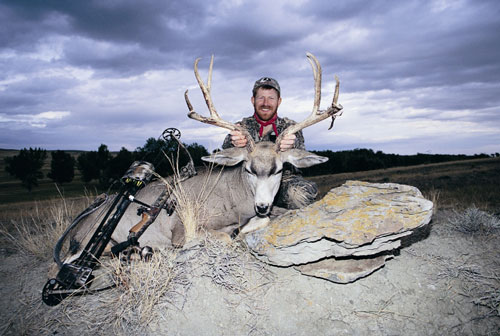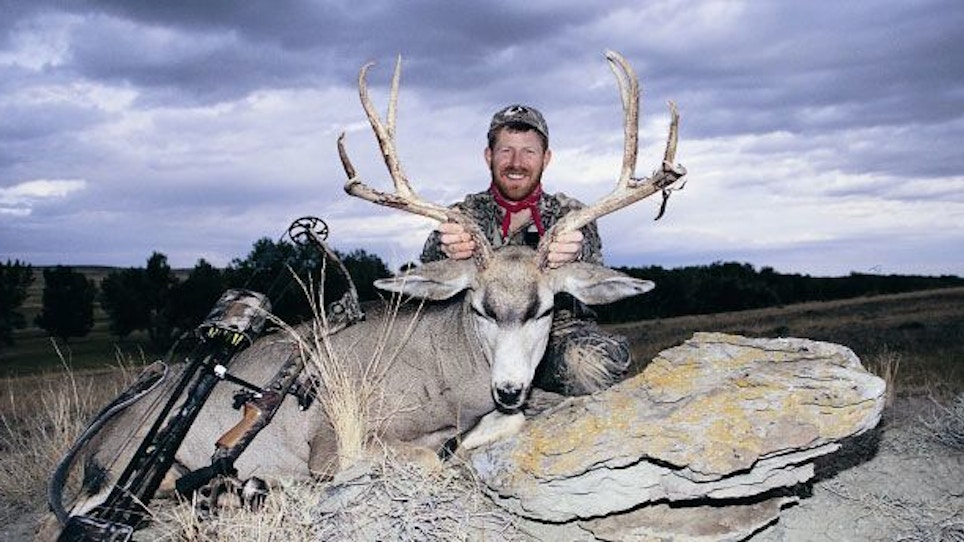Prairie Mule Deer
 Outfitter Jimmy Fontenot has been guiding mule deer hunters in eastern Wyoming for nearly two decades.
Outfitter Jimmy Fontenot has been guiding mule deer hunters in eastern Wyoming for nearly two decades.
“A realistic goal for archers on my hunt is a buck scoring between 140 and 150 inches. A patient hunter might get a chance at a much bigger buck. Our biggest bow-killed buck scored about 180 inches,” Fontenot said.
“Optics are everything on this hunt. We start each morning glassing from the vehicle or a high vantage point. I like glassing from the truck at first light because it allows us to move quickly and cover more ground than if we were on foot. Once a buck is spotted, we will watch him bed down then try a stalk. In the evenings we watch bucks come out of the ravines and coulees, then try to use cover or breaks in the land to get close enough for a shot. On good days an archer will get one stalk in the morning and another in the afternoon.”
The first day of my September 2001 Wyoming mule deer hunt was as good a day of hunting as you could ask for. I saw 33 bucks ranging in size from young fork horns to a couple of wide 4x4s that would make any archer drool. Early season means bucks are usually in bachelor groups, and they are not nearly as spooky as they become later in the season. The bunched-up bucks are easy to spot, as they spend lots of time in the open, but they are tough to stalk. Late in the afternoon I attempted a stalk on a symmetrical 4x4 that we guessed would score about 160 inches, but he was accompanied by six other bucks and I never got closer than 100 yards.
At noon on the second day of my hunt, I learned a valuable lesson. You can’t shoot a big buck if your bow is in the truck. Sounds simple, right? Here’s what happened.
From one of the main ranch roads I spotted a respectable 3x3 buck bedded in the shade of a row of willow trees. The tall willows lined a shallow ditch and provided the only cover for a quarter mile. The buck under the willows was too small to shoot this early in the hunt, but I decided to loop around with my camera and take some photos.
When I belly-crawled through the sage and up to the lip of the ditch, I got an unexpected surprise. Bedded less than 20 yards away and staring right at me was the same big 4x4 buck from the previous afternoon! He was lying in a shallow depression that we couldn’t see from the road. I was armed with only a telephoto lens, and the buck obviously knew that. He stood for one long minute then casually walked out to about 40 yards and stood next to the 3x3 buck. I cranked-off a roll of film at both bucks, but wished for my Mathews bow instead of my Canon camera. Finally, the two bucks galloped across the prairie. I spent most of the afternoon trying to re-stalk that buck, but he was super-alert and I never got within range. Lesson: Even if you can see only one bedded buck, chances are good that during the early season he’ll have at least one partner with him.
Late in the afternoon on Day 3 I got a second look at an old white-faced 4x4 buck in a dark ravine. I passed this same buck on the first morning, but decided now that he was plenty big enough. A short stalk and one long bow shot later and my tag was filled. This time the camera stayed in the truck during the stalk and I was all business! The buck’s live weight was about 225 pounds, and his yellow-colored rack sported shreds of dried velvet dangling off the beams.
Western prairies might seem bleak and lifeless at first glance, with barely enough cover to hide a jackrabbit, but find a stretch of tall trees and shallow water winding across these plains and you’ll likely find bowhunting gold. Whether your passion is rutting whitetails or early season mule deer, Western waterways have something for every bowhunter. The toughest part is deciding which species to hunt.






